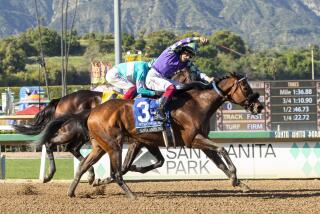America’s Cup: Winning Designer Finds Fame a Mixed Blessing
- Share via
SAN FRANCISCO — “Fame is the pits. Fame is awful. It’s not something you want once you achieve it.” --BEN LEXCEN, designer of Australia II
For 20 years, yacht designer Ben Lexcen chased an elusive siren named the America’s Cup.
The quest at times was almost mythical with the silver trophy vanishing when it came within reach. In 1983, Lexcen and a group of Dutch scientists decided to gambled on high technology and a revolutionary new 12-meter keel design.
The effort paid off as the winged keel gave the Alan Bond Syndicate yacht, Australia II, enough edge in speed and psychology to end America’s 132-year Cup defense winning streak.
However, the 48-year-old Lexcen found out that for the 12-meter designer the economic expectations from having one’s boat win the America’s Cup can prove to be as imaginary as the mythical sirens were to the ancient mariners.
With the Cup victory safely stashed under his belt, Lexcen went back to Australia awaiting the avalanche of requests for his services as a boat designer. For more than a year, he waited but not one contract came his way.
In 1984, he was hospitalized with a heart condition and high blood pressure linked to the tension and anxiety of the America’s Cup hunt. Lexcen’s experiences have made him reevaluate the fame the victory brought him.
“Fame is the pits,” Lexcen said of the aftermath of winning the Cup. “Fame is awful. It’s not something you want once you achieve it.”
Times have since gotten better for Lexcen. He has made a number of commercials on Australian television pushing among other things Toyota automobiles, Hewlett-Packard computers and a laundry soap.
His ocean yacht design business has also picked up and his latest boat--Australia III--won this year’s world 12-meter championships off Perth. He is also designing Australia IV, a boat that will challenge Australia III for the right to be the Cup defender.
While the Cup has proven to be only half full for Lexcen, it has been a haunting nightmare to Johan Valentijn, the designer of 1983 loser Liberty.
When fingers were being pointed after the loss, Valentijn and losing skipper Dennis Conner bore most of the blame.
“I think for those involved in the Cup defense the last time there is a great deal of pressure,” he said. “It was my boat that lost the America’s Cup the last time. We (he and Conner) have the most incentive to get it back.”
Valentijn is the designer of the 12-meter entry for the Long Beach Eagle Syndicate. Conner is the skipper of the San Diego Sail America challenge and has launched one of the highest-priced Cup efforts in history.
A combination of factors came together to help Australia II win the Cup. The first and foremost, most syndicate officials agree, was the false security created by the long Cup win streak. While Lexcen and his mates were using high technology to push yacht racing to new frontiers, the New York Yacht Club group decided to rely on traditional yacht design knowledge.
Valentijn said the Australian victory has changed that and ushered in yacht racing’s age of technology.
“I didn’t even own a personal computer before the 1983 challenge,” the Liberty designer said. “Now I use a very complex computer system a great deal of the time.”
Valentijn latest entry--Eagle--is scheduled to be christened April 6 and is rumored to have a winged keel that has taken the device to its next evolutionary step. The new design was discovered during tank testing and so excited Valentijn and the syndicate that extra time and an additional $200,000 was allocated for further testing.
“Some people might describe what we’ve done as ‘rather risky,”’ Valentijn said of the new design. “I don’t feel that way. Rather than call the keel a ‘breakthrough’ now, I’d just as soon wait and let Eagle’s performance on the water do the talking.”
Valentijn said he thought other syndicates already knew something about his new keel design.
“The secrecy surrounding the America’s Cup is more a thing in the public’s mind than what actually exists,” he said. “I have people who have told me about what the other syndicates are doing. The last time, I knew six months before the race what the Australians had.”
However, Valentijn said the idea of a winged keel seemed to risky before the 1983 race.
“The idea had been around for a while,” the designer said. “But it hadn’t been put on a 12-meter boat before. The principle itself is simple, but if it’s put on in the wrong way, it can make the boat very slow. They (the Australians) did it right.”
Valentijn said he felt a costly design campaign, which has cost more than $1 million for most of the American syndicates, was necessary if a challenge was to be competitive.
“If you look at the dollars spent compared to what has been gained in 12-meter design, you would have to say the spending has been outrageous,” he said. “But if you want to get ahead you have to spend time and money.”
Valentijn, a man who knows the pain and agony of losing the Cup, said he felt his syndicate’s time and money “was well spent.”
“I don’t plan on losing again,” he said.
More to Read
Sign up for Essential California
The most important California stories and recommendations in your inbox every morning.
You may occasionally receive promotional content from the Los Angeles Times.













